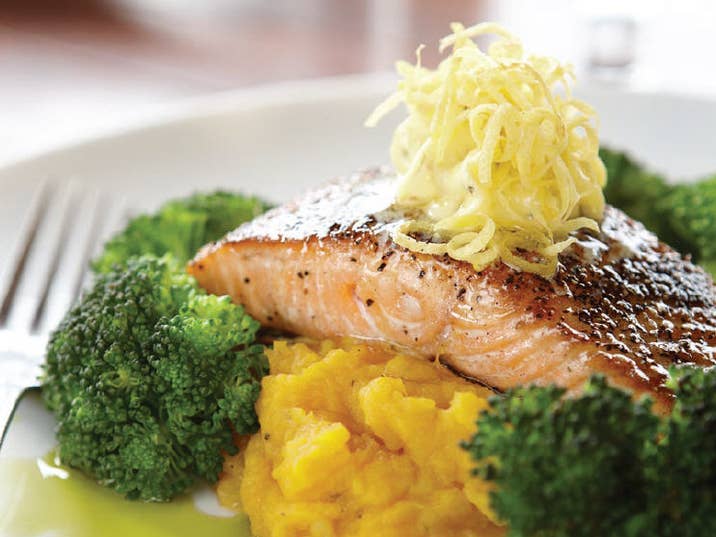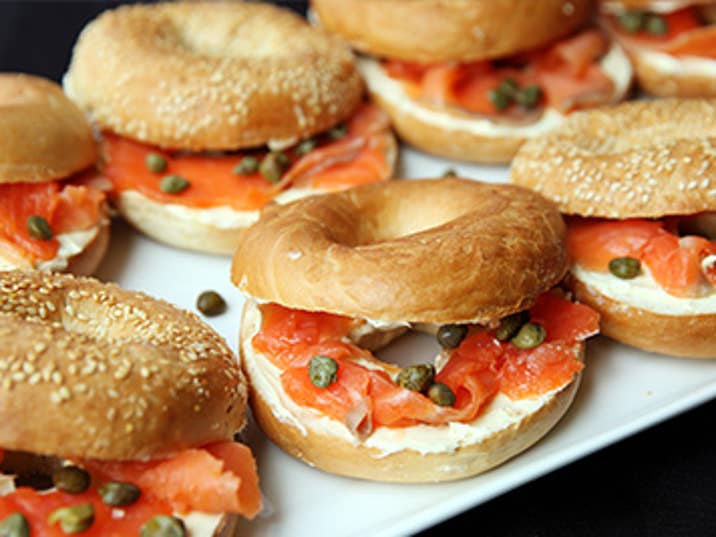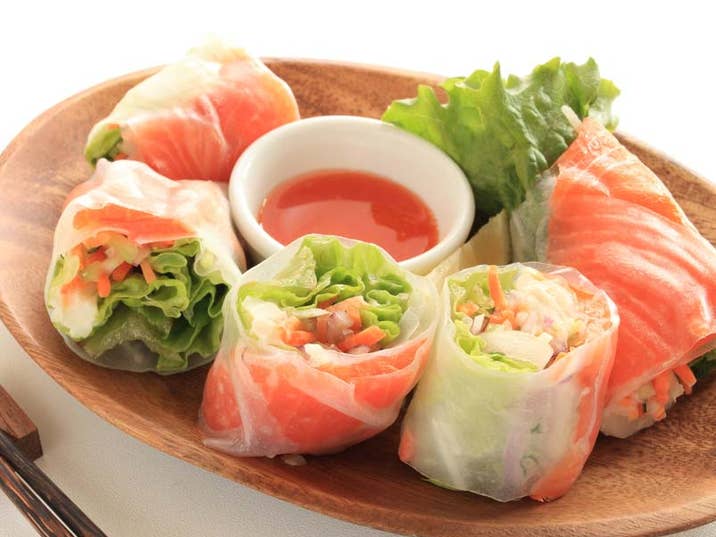How to Prepare & Cook Delicious NZ Salmon - Types of Salmon, Storing & Recipe Ideas
How to prepare and cook delicious NZ salmon
Learn how to save money when preparing and cooking fresh NZ salmon so you can enjoy eating more whilst spending less.
Making the most of NZ salmon
New Zealand Salmon Season: NZ Salmon is in season from early October (Spring) through to late April (Autumn).
Buying fresh salmon when it’s in season means you and your family get to enjoy it at its tastiest and most nutritious. It’s also a great time to buy salmon in bulk when it’s cheaper and freeze it. Below we reveal alternative ways to prepare and cook salmon, so you can continue to eat well, whilst spending less on groceries.
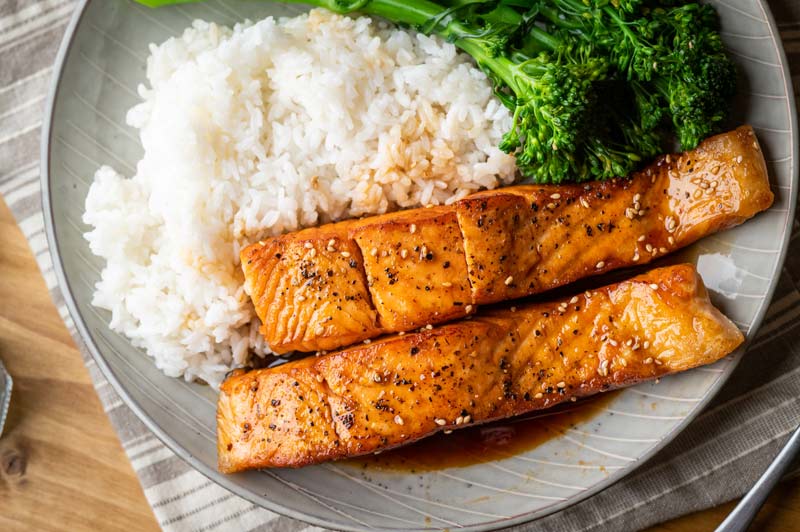
Types of salmon
King salmon and Atlantic salmon
There are two main salmon species available to buy in NZ, they are King Salmon and Atlantic Salmon. King Salmon is the only salmon species actually farmed in New Zealand, in and around the South Island. Atlantic salmon is grown in Atlantic waters and imported in Winter, when King Salmon is out of season.
Salmon can be bought fresh, frozen, smoked and canned
If you want fresh salmon you can buy a whole fish, a whole side, individual salmon fillets, salmon steak or salmon pieces depending on the dish you're planning to cook. Buying a whole fish or side of salmon is often cheaper per kilo than buying fillets which require additional handling in store. The advantage of these larger cuts of salmon is that you can trim the head, the tail, the belly and the fins to use in your fish stock or stews, capturing their delicious flavours with nothing going to waste.
Salmon is also available to buy frozen, smoked and canned and these are all perfect options if you plan to use the fish at a later date.
To help you make the right choice, we explain the differences between different types of salmon below.
Related: What's better, fresh or frozen fish and seafood?
Fresh salmon
Fresh farmed King salmon is shipped to store within a day of being harvested. This is when it's at peak quality, with a rich flavour and maximum nutritional benefits. It has a lovely bright pinkish-orange hue and a neutral odour. Fresh King salmon is best cooked simply in a pan on the day of purchase, with little more than a twist of lemon and freshly ground sea salt to bring out its delicious flavour.

Frozen salmon
When you buy frozen salmon, it's likely that it was frozen immediately after being caught at sea and it should provide you with the same nutritional benefits as fresh salmon. Flash freezing perfectly preserves the texture, taste and freshness of just-caught salmon. Filleted, frozen salmon is often cheaper to buy than fresh salmon so watch out for in-store freezer specials and buy in bulk.
We recommend you leave frozen salmon in the refrigerator overnight to allow it to defrost, then at room temperature for an hour, to allow more even cooking. It can be prepared and cooked in exactly the same way as fresh salmon and it will taste just as good.
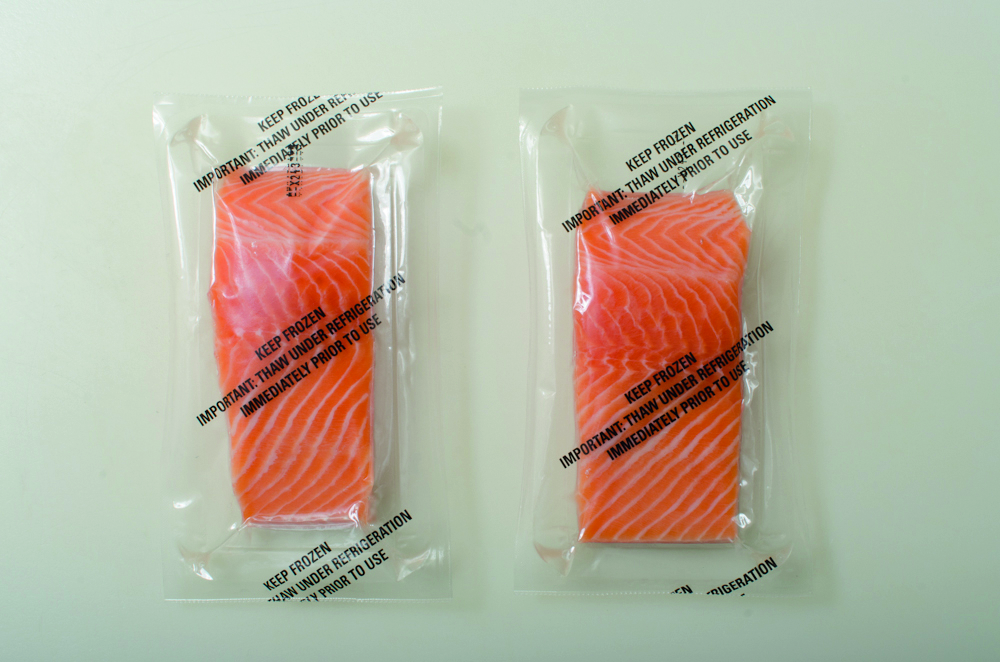
Smoked salmon
Smoking is a popular method of preserving and adding flavour to salmon. In fact, dollar for dollar, smoked salmon adds far more flavour to a dish than fresh salmon, so you’ll find a little will go a long way in your dishes.

There are two methods of smoking:
Cold smoked salmon is usually cured in salt overnight, then smoked at a low temperature to flavour the salmon without actually cooking it. Sold thinly sliced in packs of 100g - 200g, this is the classic smoked salmon pieces we usually top our cream cheese bagels with.
Pick up a pack with your next shop and try chopping and stirring the smoked salmon through a creamy pasta sauce with some cherry tomatoes and capers for a great tasting, low budget family meal option. 100g should feed 2-3 people.
Hot smoked salmon uses a higher smoking temperature to "cook" the fish resulting in a flaky fish texture and deep smoky flavour. These are sold in individual vacuum sealed portions in the chilled fish section and are available flavoured with lemon, black pepper or chilli seasoning.
A single portion pack will provide enough to flake over a warm potato salad for 4 or to sprinkle over poached eggs and hollandaise for a flavoursome brunch dish.
Canned salmon
Canning is another method of preserving salmon. The nutritional benefits are very similar to fresh salmon, although canned salmon contains more calcium from the soft, edible small white bones it contains
Canned salmon doesn't resemble fresh or frozen salmon in either taste or texture and can't generally be used as a true substitute. It is however a great pantry staple for use in sandwich fillings, cold salads, salmon patties and pasta dishes.
Red and pink canned salmon are both highly nutritious. Red salmon is richer tasting, firmer, fattier and higher in calories than pink salmon which is milder and softer. Red salmon is rarer and the more expensive of the two.
The best cuts of salmon
There are 5 main cuts of salmon available.
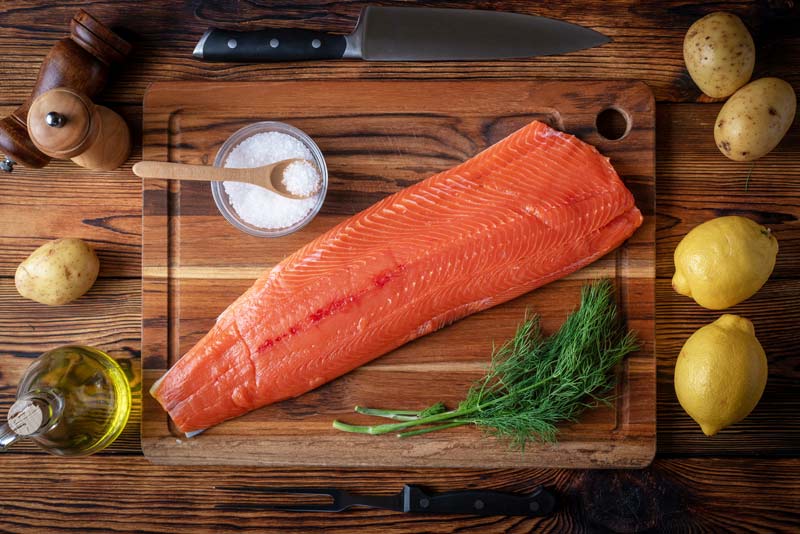
The whole fillet or side
The whole salmon can be cut into 2 sides or whole fillets which extend from the tail to the head. These are perfect for poaching, roasting or smoking.
Tail fillet and shank
The tail fillet is narrower, boneless and leaner than the rest of the fish. It makes a delicious salmon tartare and can be cubed and pan fried for a taco, fried rice, kedgeree or salmon pasta salad.
Portion
Cuts across the fillet from the belly up to the backbone are referred to as a portion. When cooked with a crispy skin, these are delicious pan fried, grilled and roasted. They can also be poached in a rich fish bisque and served with crispy French bread.
Salmon loin
The loin is the premium salmon cut from the main part of the fish above the belly and is prized by chefs for its culinary versatility. The flavorful lean cut loin is the healthiest part of the salmon, comes at a premium price and can be roasted, sauteed, grilled, poached or smoked.
Belly fillet
The section running horizontal to the loin is the belly fillet which is the fattiest part of the salmon. Often whiter in colour, belly fillet is the cheapest cut of salmon and appreciated in Japanese cooking and Sashimi. The belly can be used in leftover recipes to transform the flavour of seafood chowder, fish soup, fish stock or pasta sauces.
Storing salmon
As with any fish, salmon should be stored completely wrapped, to prevent it from drying out and releasing a strong fishy odour in the refrigerator. Salmon is best eaten as fresh as possible and can be stored in the fridge for 3 to 4 days if vacuum sealed and preferably covered with ice.
Fresh salmon: Once cooked, salmon should be kept in an airtight container, refrigerated and consumed within 3 days to be enjoyed at it’s best. If you don’t plan to eat it immediately, you can freeze fresh and cooked salmon, as long as it hasn't previously been frozen, for up to 6 months. You should always defrost salmon thoroughly in the fridge before consuming and never refreeze.
Smoked salmon: Smoked salmon will normally stay fresh in the fridge for over a month from the date it was packed. Always check and refer to the use by dates printed on the packaging. You can also freeze smoked salmon in an airtight container for up to 6 months.
Preparing salmon
The following guidelines apply to the recommended preparation of salmon before most cooking methods:
- Bring salmon back to room temperature before cooking. This will prevent the unsightly white protein from seeping out of the flesh when cooked.
- Don't rinse or wash salmon - it isn't necessary. Any bacteria will be destroyed during cooking
- Using kitchen paper, pat the surface of the flesh and skin dry (this is crucial if you want a crispy skin).
- Leave the skin on during cooking, even if you don't want to eat it. It seals the moisture in and makes it easier to flip over without falling apart.
- Use a clean pair of tweezers to remove any small white bones.
- Season with salt which helps to keep the moisture locked in.
Eating salmon raw
You can eat fresh salmon raw (it does not need to be cooked). The best quality fresh salmon can be eaten raw in poke bowls, salmon tartare and in salmon sashimi. It's safe to eat salmon raw and to serve it rare, however pregnant women and the elderly should avoid raw fish just as they would avoid undercooked meat and eggs.
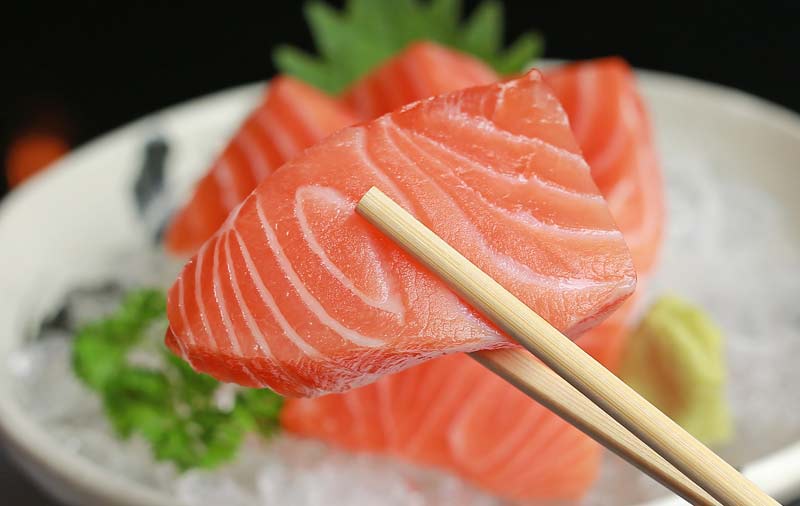
Cooking salmon
Salmon cooks quickly and the cooking time will vary depending on its thickness. Below are the recommended cooking times for individual salmon portions and a whole side of salmon as an example. If you have very thin salmon portions, we recommend you reduce the cooking time, if you have very thick portions, then increase the cooking times stated.
To check if salmon is cooked, insert a thermometer at the thickest part. The internal temperature should be between 61 and 63 C. Once taken off the heat, salmon will continue cooking with the residual heat. Allow to rest for 3-5 minutes before serving.
Salmon is an oily fish so you should avoid cooking it in oil. Butter will add flavour and the fat required to prevent it from sticking.
Cooked salmon skin is delicious when cooked until crispy. If you don't like salmon skin then cook fully and chop into treat sized pieces for your dog or cat to prevent any waste.
Baked salmon
Salmon can be oven baked at 180 C. A portion will require 8-10 minutes (flip halfway though for crispy skin) and a full side will require 25-30 minutes.
Pan frying
Pan frying salmon is quicker than baking and achieves a better crispy skin. Lightly grease a non-stick frying pan with butter. Heat to medium then place the salmon in, skin side down. Baste for 3-4 minutes each side. A whole fillet will require up to 15 minutes on each side.
Air frying
Air frying is becoming an increasingly popular cooking method and it's not hard to see why. There's no preheating required, your salmon will be cooked to crispy perfection in under 10 minutes and there's minimal clean up. It’s a convenient, low cost way to cook family meals and save time into the bargain. Season the salmon and place skin down in the air fryer and cook at 200 C for 7 minutes before checking if it's cooked to your liking.
Grilled salmon on the BBQ
The secrets to successful grilling on the barbecue is to maintain a medium heat to prevent charring, to pat the salmon dry and to brush with oil and season well. Also lightly oil the grill plate then add the salmon skin side down. Cooking times are similar to pan frying: just 3-4 minutes on each side for a portion and 12 minutes each side for a larger side.
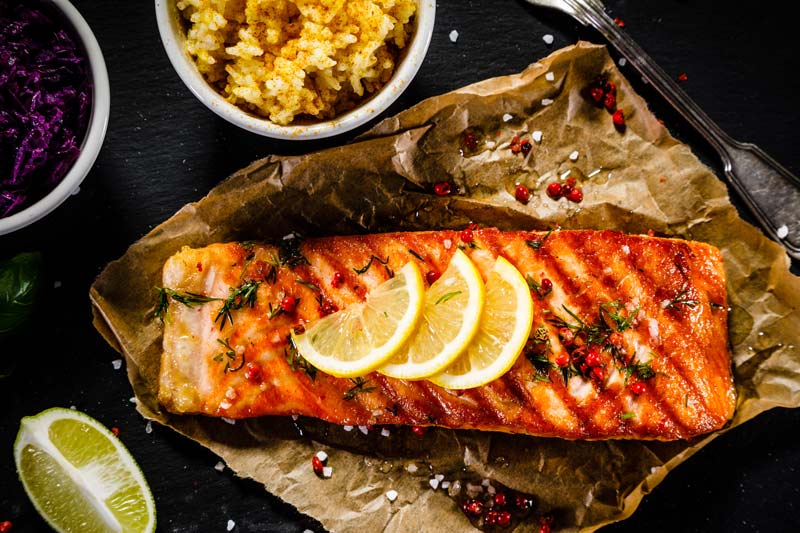
Oven grilling
Preheat your grill to medium high heat. Marinade the salmon with a little honey and season well. Grill a portion for 4 minutes each side or a whole fillet for 28 minutes on one side - no need to turn over.
Poached salmon
Poaching salmon is one of the healthiest, low fat ways to cook salmon and is a particularly popular cooking method in the hot Summer months when you don’t want to spend hours in the kitchen.
- Start with a fish poacher or shallow saute pan, half filled with water, white wine or seasoned coconut milk, then flavour with lemon, parsley, bay leaf, black peppercorns and ginger.
- Warm to a constant temperature of 80 C.
- Place your salmon into the poacher and ensure it is completely covered in poaching liquid. Cook for 5-7 minutes for a salmon portion or 40 minutes for a full side of salmon.
- Remove the skin and any dark flesh - which can be mixed in with your pets food for a deliciously fishy treat.
Poached salmon can be eaten immediately or better still, refrigerated and served over the next few days with lots of fresh, crunchy salads on the side.
Microwave
If you want to quickly cook raw salmon to add to salads or other dishes, the microwave makes quick work of it. Cover with cling film and cook on medium heat for 3-4 minutes for a portion or 10-12 minutes for a full side.
Related: How to cook with seafood
Leftover salmon recipes
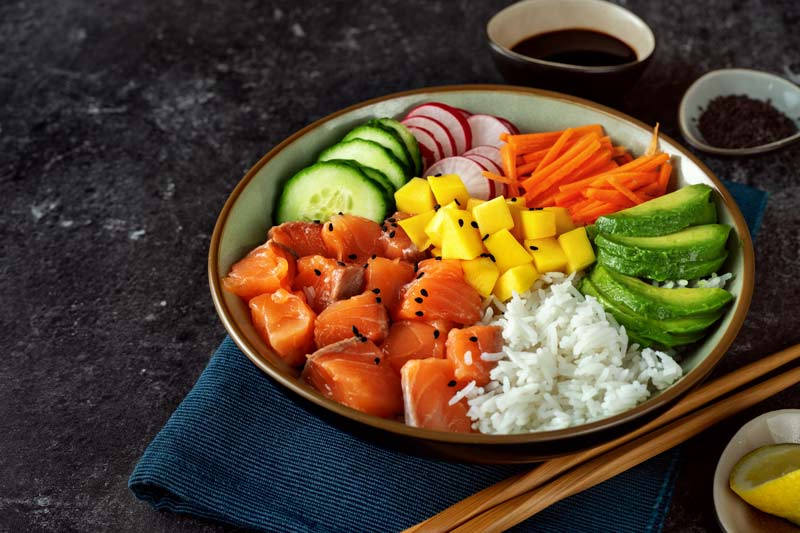
There are plenty of tasty dishes you can rustle up with a little leftover salmon. It's too good to waste so have a go at making one of the recipe ideas below:
- Salmon fish cakes can be made using leftover salmon with mashed potatoes, dill, parsley and breadcrumbs then fry in a shallow frying pan. Serve with tartar sauce.
- Make a hearty pan of breakfast kedgeree with smoked salmon flakes, basmati rice, curry powder, lemon, butter and soft boiled eggs.
- Toss leftover salmon flakes into a bowl of nicoise salad in place of the usual tuna.
- Make a salmon dip with leftover salmon, cream cheese, horseradish cream, lemon, fresh dill and capers..
- Stir leftover salmon chunks in with scramble eggs and serve with hot buttered toast.
- Spread cream cheese on multigrain bread, top with leftover salmon and pickled gherkins for amazing sandwiches.
Eating fresh versus frozen seafood for less
Remember, buying fresh New Zealand salmon when in season means you’ll enjoy our produce at its freshest, tastiest and most nutritious. It’s the perfect way to make your weekly food budget stretch further so you can continue to eat well, whilst spending less.
If you’d like to find out what else is in season at this time of year, visit our Fresh Market Update. Click here to discover more ways to save money on groceries.
